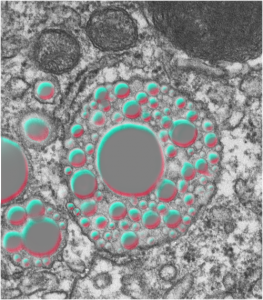The lysosomes in this alveolar macrophage from a mouse which breathed E2 for 3 hours and then allowed to recover for 5 days are awesome. The macrophage has produced enzymes which re-emulsify the E2 into very small (in most cases) droplets within the lysosomal structure. In addition, the enzymes make a border, which is very difficult to distinguish from the trilaminar membrane which surrounds the lysosome proper. I don’t know how to explain this look of a double membrane, but figure it is partly a physical interaction between the E2 droplet (and not unique to E2 but seen with many other perfluorochemicals) and its hydrophobicity, and slight lipophilicity.
The smallest spheres of E2 are down around 35nm diameter, and size can be compared to something just larger than a ribosome (@27nm). Picture on the top is the unretouched (i may have removed a scratch with the band-aid tool in photoshop but nothing else), and it is not too great an image (scanned from the 31/4×4 acetate negative), but interesting still, and providing lots of information. Image below is one where I have highlighted the E2 droplets in a single membrane bound lysosome and embossed them.
The dark structure (also rounded) in the upper right hand corner of the images is what I think is a phagolysosome that contains mostly phagocytosed surfactant lipids (some layering and myelin-look is seen within this structure) from the alveolar space. There are also two mitochondria near center top. It also seems likely that some of the surfactant engulfed by alveolar macrophages would find its way (during re-purposing or re-cycling) into such lysosomes containing E2 droplets.

